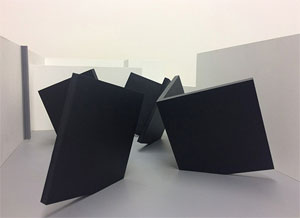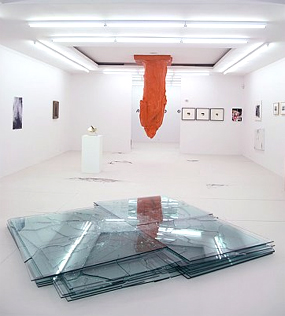Zombie Minimalism
John Haberin New York City
Kishio Suga, Thomas Lendvai, and Barry Le Va
Remember when painting was declared dead, only to return from the dead? Critics complain of zombie formalism, which misses the refusal to abide by formalism. Still, they may have a point: like zombies, art these days is often derivative, undisciplined, and unruly. On its best days, that can even contribute to its vitality.
One might say the same about sculpture. It, too, can fall in the shadow of American Minimalism, like Kishio Suga in Japan. Thomas Lendvai, for another, rivals Minimalism in his geometry and blackness, while taking both apart. And, speaking of zombies, Barry Le Va takes Minimalism close to murder, with a recreation of his Cleaved Wall. Their sculpture may lack weight and rigor, but it can get up off the floor and almost dance. For Lendvai, that begins with a throw of the dice. 
Minimalism as lightweight
As Minimalism goes, Kishio Suga is a lightweight. Not that his largest and latest work lacks heft. Its cracked timbers rise nearly to human height, with a thickness that would embarrass a human waistline. Slim metal beams lie across them as well. Together, they construct a monumental architecture, with the plinths as ancient columns and the metal a modern steel frame. If they lack for walls, unlike Richard Serra, so does the Parthenon.
Like architecture, too, or for that matter like Serra, they are both welcoming and confining. Feel free to explore, at Dia:Chelsea before its 2021 relocation, but on their terms. In the course of exploration, you may see them at any given moment as a game, a comfort, or a threat. You may wish to be careful so as not to knock them down, lest you injure a work of art, another human being, or yourself. Serra's rusted steel can seem precarious, too, even at its weightiest. Still, for all his ambition, Suga's obstacle course is far lighter, more open, and deliciously random.
Suga is like that, and so is Mono-ha, the Japanese counterpart to Minimalism. Where Minimalism works between sculpture and industry, the Japanese movement works between architecture and landscape. It often rises vertically, where an American like Carl Andre would hesitate to defy gravity, but with open sight lines. It also both accepts accident and human intervention. Additional steel plates stack between many of Suga's beams, to level them. The weathered materials seem more natural than impersonal.
Like a Japanese garden, they also come with spiritual pretensions that an American would shun. Suga calls them Law of Halted Space, while other titles speak of phases and transformation. Together, the six works amount to a modest retrospective, from 1968 to the present. A stone looks left over from the building's infrastructure, perhaps as a door, with the artist's doodlings in vinyl. Others stick to wood, metal, paint, stone, and earth. More than Lee Ufan, Suga has to get back to the garden.
More than others, too, he is not above muss and fuss. It weakens the smaller works while heightening the larger ones. The second largest connects its stones by wrapping them in thick wire. Another depends on Suga to hold it up. Where John McCracken would simply lean a plank against the wall, he leans two against each other—and even that does not promise a firm balance. He has to place stones at the feet of each one.
The fuss can get in the way of what Minimalism and Mono-ha share most. At their best, both oblige one to focus not just on objects, but also on oneself and one's environment. When human perception does play a role, it does not always play to the work's benefit either. Friends swore that the wood smelled like puke. (Maybe they should have reflected on what that says about the normal treatment of materials or about themselves.) As a sculpture garden, the installation may appear at its most enticing as one looks from one work to another.
A throw of the dice
When Thomas Lendvai flings a die across a Bushwick gallery, he leaves nothing to chance—nothing, that is, but the experience. Minimalism long invited one to walk on the art, as with Carl Andre, or to look away or within. Lendvai, too, allows one to choose one's path, but with a few surprises along the way. What looks like an obstacle becomes an opening, and what looks like an exit becomes an inner sanctum or a dead end. The six titled planes may join in a V or have a corner cut off by the floor, as if sunk right in. They all but dare one to reassemble them as a cube.
Toute Pensée émet un Coup de Dés. ("Every Thought issues a Throw of Dice.") The words come at the end of Un Coup de Dés Jamais N'Abolira Le Hasard, the book-length poem by Stéphane Mallarmé from 1897. Its wide-open layout and seemingly random capitalization keep one reading, thinking, and guessing. Is this book art, free verse, or a surrender to language itself—or a clue to Lendvai? No matter, for (to translate the title) "a throw of the dice will never abolish chance."
Minimalism can be exhilarating or threatening. Tony Smith called his mammoth black cube Die, with the obvious pun, and Lendvai could have dismantled it for the occasion. The work's precarious balance also recalls Richard Serra. Lendvai, though, is more likely to mention Mallarmé and early Modernism. If a painting by Kazimir Malevich became an installation, would it look like this? Maybe it depends on scale.
Russian Constructivism left plenty of sculpture, and it looks nothing like Minimalism or zombie formalism. It does not often echo the surrounding architecture. It certainly does not sink into the floor. Still, Lendvai has a point. His planes seem to float, like a black or white square by Malevich, for all their firm contact with the ground. Their dance more than mitigates the threat.
Kurt Steger, too, leaves himself open to experience, but he means to include the experience of the outside world. Like Lendvai's, his sculpture plays with its own weight. It suspended from the ceiling at the same gallery just a few months earlier, like an enormous Chinese lantern. It offered a kind of protection, like a paper canopy, but also a puzzle: what accounts for its irregular shape? He found that shape in a city park.
He also inverted what he found, much as Lendvai turns a cube inside-out and at the same gallery. It may look like a chunk of granite, the kind that kids climb all over, but instead he molded it from one—as with the smaller models that he exhibits as sculpture. One has to imagine the rock filling the gallery beneath its edges. He calls it Scribing the Void, with an equal emphasis on writing, drawing, and emptiness. It may sound scary to enter the void, even with a scribe and even in the park. But then good kids know when to take chances.
Minimalism and murder
If I were you, I would have been very careful not to get drunk at the opening of Cleaved Wall, by Barry Le Va. I am still weighing the risks, as Le Va intended. He wants one to feel the work viscerally—from the weight of the thirty-four meat cleavers, the kind from a butcher's shop, to their 9½-inch blades. He wants one to imagine how they got stuck in the walls. Did he fling them, and from how far away? Did he know where they would land?
 Not that I can swear the gallery served alcohol. (There was no sign of it when I passed through half an hour before.) If so, I am sure that the event took due diligence, just as raised wire keeps one at due distance from that corner of the room. Still, the installation demands to be seen in bodily terms, beginning with its origins. Le Va purchased the cleavers in the meat yards of Chicago—the subject of Upton Sinclair's muckraking in The Jungle, the 1906 novel. The work first went on view in 1970 at the Whitney, where drinks were scarce.
Not that I can swear the gallery served alcohol. (There was no sign of it when I passed through half an hour before.) If so, I am sure that the event took due diligence, just as raised wire keeps one at due distance from that corner of the room. Still, the installation demands to be seen in bodily terms, beginning with its origins. Le Va purchased the cleavers in the meat yards of Chicago—the subject of Upton Sinclair's muckraking in The Jungle, the 1906 novel. The work first went on view in 1970 at the Whitney, where drinks were scarce.
Where have the blades lay since, and how did they get into the wall? One row runs just above the floor, another high on the wall. The first dares one to picture the cost of coming too close. The second defies one to stand under them—or to imagine the artist flinging them like props in an action movie, on a ladder or even (less plausibly) from the floor. Their shifting angles relative to the wall evoke stop-action photography of a single blade. Either he or the fine wood handles could be dancing.
One thinks in human terms, too, because Minimalism and process art demand it, and Le Va had a serious role in both. Minimalism obliges viewers to contemplate themselves and the gallery along with the sculpture, as part of a living theater. Process art insists that the theater unfolds in time. When Le Va produced his "scatter pieces" of torn felt, they made a mess. When Serra flung molten lead, the mess was not so easy to clean up. When Walter de Maria brings earthworks indoors with his New York Earth Room, one can only wonder how long it took to cart the black soil into the gallery—and how much human intervention it takes to keep anything from growing.
Le Va may not match their reputation. The scattered felt can seem too arbitrary and too little visceral. One cannot smell soil or shy away from lead. Still, his materials have included shattered glass (as seen here in 2007), the kind that Chris Burden dragged himself across, and guns. Besides, he cherishes the arbitrary gesture, much like drip painting and gestural abstraction. It may sound odd that he planned the near random arrangement of blades, cuts, and handles, but the show comes with drawings to prove it.
Their interplay of thought and impulse becomes a dance. So does another product of Chicago in the back room, Floret by Julia Fish. It makes no attempt to reproduce the 1998 original, for which Fish expanded on green sections of institutional floor tiling, separated by white. Rather than add complete circles, she had her own arbitrary placement of small hexagons. In works on paper for the occasion, the clusters seem to grow before one's eyes. They could pass for pixels in motion from video games—or plain old drunk.

Kishio Suga ran at Dia:Chelsea through July 29, 2017, and Barry Le Va and Julia Fish at David Nolan through February 11. Thomas Lendvai ran at Odetta through February 26, 2017, Kurt Steger through August 21, 2016.




